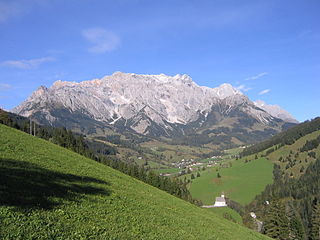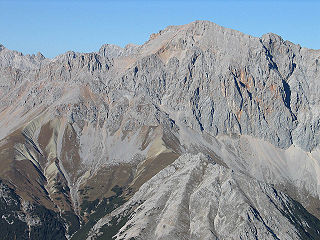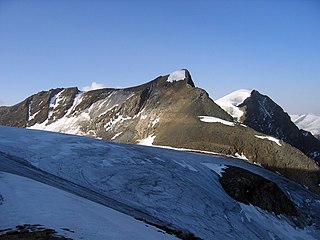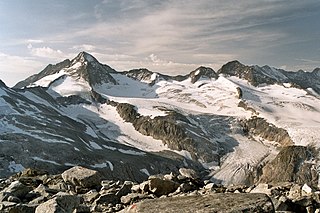| Mittlerer Sonnblick | |
|---|---|
Großer Sonnblick (centre) and Mittlerer Sonnblick (right) | |
| Highest point | |
| Elevation | 3,000 m (AA) (9,800 ft) |
| Prominence | 100 m |
| Isolation | 0.660 km |
| Listing | easternmost 3,000er of the Alps |
| Coordinates | 47°03′09″N13°25′51″E / 47.0525°N 13.43083°E Coordinates: 47°03′09″N13°25′51″E / 47.0525°N 13.43083°E |
| Geography | |
| Parent range | Ankogel Group, High Tauern |
The Mittlerer Sonnblick is a 3,000 metre high [1] sub-peak of the Großer Sonnblick (3,030 m) to which it is linked by a knife-edge ridge. It is a border peak between the two Austrian federal states of Carinthia and Salzburg. It lies within the Ankogel Group of mountains, a sub-group of the High Tauern.
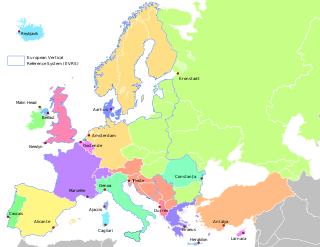
Metres above the Adriatic is the vertical datum used in Austria, in the former Yugoslavian states of Slovenia, Croatia, Bosnia-Hercegovina, Serbia, Montenegro, North Macedonia, Kosovo, as well as in Albania to measure elevation, referring to the average water level of the Adriatic Sea at the Sartorio mole in the Port of Trieste.

The Großer Sonnblick or Malteiner Sonnblick, a mountain with a height of 3,030 m (AA), is a peak in the Ankogel Group of the Hohe Tauern range in Austria. It is the easternmost peak of the Alps with a prominence over 100 metres that exceeds a height of 3,000 metres (9,800 ft).

Austria, officially the Republic of Austria, is a country in Central Europe comprising 9 federated states. Its capital, largest city and one of nine states is Vienna. Austria has an area of 83,879 km2 (32,386 sq mi), a population of nearly 9 million people and a nominal GDP of $477 billion. It is bordered by the Czech Republic and Germany to the north, Hungary and Slovakia to the east, Slovenia and Italy to the south, and Switzerland and Liechtenstein to the west. The terrain is highly mountainous, lying within the Alps; only 32% of the country is below 500 m (1,640 ft), and its highest point is 3,798 m (12,461 ft). The majority of the population speaks local Bavarian dialects as their native language, and German in its standard form is the country's official language. Other regional languages are Hungarian, Burgenland Croatian, and Slovene.
The mountain has a prominence of 100 metres and an isolation of 660 metres. [2]
The peak has achieved certain renown, no doubt because it is the easternmost three-thousander in the Alps. It is certainly not wrong to say that the Großer Sonnblick is the easternmost mountain in the Alps that exceeds the 3,000-metre mark, but it is not the easternmost point in the Alps that reaches that height.
Three-thousanders are mountains with a height of between 3,000 metres (9,800 ft), but less than 4,000 metres (13,000 ft) above sea level. Similar terms are commonly used for mountains of other height brackets e. g. four-thousanders or eight-thousanders. In Britain, the term may refer to mountains above 3,000 feet (910 m).

The Alps are the highest and most extensive mountain range system that lies entirely in Europe, separating Southern from Central and Western Europe and stretching approximately 1,200 kilometres (750 mi) across eight Alpine countries : France, Switzerland, Italy, Monaco, Liechtenstein, Austria, Germany, and Slovenia. The mountains were formed over tens of millions of years as the African and Eurasian tectonic plates collided. Extreme shortening caused by the event resulted in marine sedimentary rocks rising by thrusting and folding into high mountain peaks such as Mont Blanc and the Matterhorn. Mont Blanc spans the French–Italian border, and at 4,810 m (15,781 ft) is the highest mountain in the Alps. The Alpine region area contains about a hundred peaks higher than 4,000 metres (13,000 ft).





